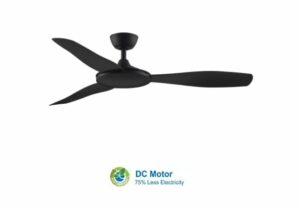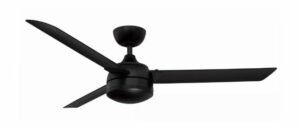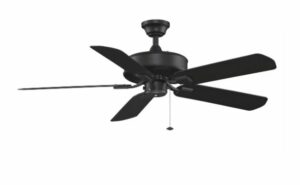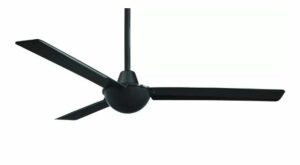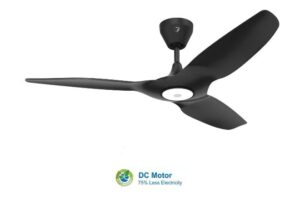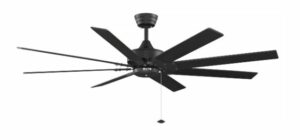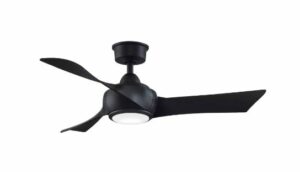Black Ceiling Fans make aesthetically beautiful additions to just about any room in the house. They look great against white ceilings to provide a great contrast too! It should be said that with all the fans we looked at, a large number of them are also available in other colors if you’d like. Be sure to also check out our extensive buyer’s guide at the bottom. In it, we discuss everything you need to know about evaluating a ceiling fan.
The Fanimation Spitfire is a lightweight indoor ceiling fan that keeps your energy consumption in check. The fan features ultra-wide 60” wooden blades mountable with a 21-degree pitch. As they weigh quite less than metal blades, they impose less pressure on the motor. As a result, you enjoy natural & breezy airflows minus the disrupting noise and hefty utility bills.
The current model comes with a 6” downrod perfectly suitable for living room or bedroom with average-height ceilings. It also features an optional LED glass downlight. The led downlight features an 18-watt dimmable LED light in the form of a glass dome. You will get a Bluetooth remote transmitter powered by Fansync technology. By downloading the fansync app, you can control the fan via your smartphone.
Fanimation is a Zionsville based company known for designing minimalist and power-efficient ceiling fans. The spitfire lines by Fanimation full-heartedly embraces a performance-driven technology impeccably carved to enhance your room’s aesthetics.
Minka Aire Artemis is an indoor-only smart ceiling fan with a contemporary designed body. It comes with a large 58” blade span to deliver a massive airflow up to 7157 CFM. It is supported by a powerful DC motor controlled by 6 Speed settings. The blades can run in reverse motion, making it ideal for winter. We think this model in black is absolutely stunning!
The Artemis features a sleek body with glossy black blades that can transform a dull room to awe-inspiring perfection. It also includes stunning dimmable LED lighting facilitating 1746 lumens with 3000k color temperature.
The ceiling fan offers multiple options for connectivity and features to control it. For instance, besides the wall control, you get a handheld remote to adjust fan speed & LED power. Plus, the built-in BOND wifi allows you to control the device through voice assistants and smartphone.
The Minka Group is a leading US-based manufacturer and supplier of high-end ceiling fans and lightings. The Minka Aire ranges of ceiling fans are widely recognized for their premium features and contemporary designs. The Artemis LED DC LED fan is one such admire-worthy marvel from the range.
Fanimation GlideAire is a contemporary designed smart ceiling fan featuring a whopping 31 speed settings. The fan includes an energy-efficient DC motor offering a decent 5538 CFM of airflow and a wind speed of 3.21 MPH. The fan is rated for outdoor DAMP, making it suitable for indoor and outdoor usages.
It comes with a dedicated bluetooth-enabled handheld remote control with advanced fan controls. You can run the fan in both clockwise/counter-clockwise motion. Thus, you can push the air down on you during the summer to stay cool. And in the winter, you can pull the air up to stay a bit warmer.
The flagship Fansync app lets you connect the fan to your smartphone, providing more exciting features at your fingertips. You can expand your connectivity by adding a wifi module (comes extra) and control it through Alexa and Google Assistant. Currently, the fan supports all popular IoT devices like Amazon Echo, Google Home, SmartThings, Ecobee, and Nest.
Fanimation Fans is a reputed manufacturer, designer, and supplier of high-end ceiling fans across the USA. Over the years, Fanimation has marked its presence in the industry by serving aesthetics, technology, and quality on one platter. Undoubtedly, the GlideAire range of ceiling fans is a prime example of such manufacturing excellence.
Fanimation Xeno is a heavy-duty ceiling fan rated for outdoor WET usage in both covered and uncovered areas. It consists of an energy-efficient Motor attached with three ABS plastic blades. The blades are 56″ in total span and mounted at 14-degree pitch for optimum air coverage.
It comes with a beautiful LED fixture featuring an elegant opal frosted glass dome. The LED lights are dimmable and offer a decent 1440 lumens with 3000K Color temperature. You also get a bottom cap, in case you decide to install it without the LED fixture.
It offers a generous wind speed of 3.96 MPH and 7782 CFM of airflow. The fan optimizes the air distribution, making you feel cooler within seconds. Ultimately, this will save you energy costs on your AC bill.
Headquartered in Zionsville, IN, Fanimation Fans holds great credence in manufacturing contemporary, energy-efficient, and performance-driven products. The Xeno Wet is one such beautiful example.
This EdgeWood fan from Fanimation features ABS all-weather blades to perform under wet conditions. There are five blades angled at 14 degrees to provide an average airflow of 5416 CFM. It has a three-speed pull chain and moves a decent amount of air using minimal electricity. The same model is also available in four other designs for you to choose from, including Satin Nickel and Oil-rubbed bronze. But we think this model in black is absolutely beautiful!
It is UL rated for indoors as well as outdoor damp and wet locations. Thus, it can withstand small exposures to rain water under a partially covered area such as a patio or gazebo. You just need to keep the blades at least 7’ from the floor using 4 ½” downrod included in the package.
Fanimation is a well-known name for buyers looking for smart fan and lighting solutions. The company’s product catalogue contains 1000+ different fan models to amplify the beauty of your existing home décor. Out of them, Fanimation 52″ EdgeWood is a classic product with above-average performance parameters priced at a pocket-friendly quote.
This black beauty from Minka Aire comes with ABS plastic blades to promise durability. They create airflow of 6304 CFM (Avg std: 5,000 CFM) to provide enough chilling effect. The wide 52” blade span with a maximum 200 RPM motor speed covers the entire room.
The fan has multiple control options. However, the most convenient one would be to operate it through a 3 speed wall control. There is a lifetime limited motor warranty on the AC motor. You can hang it with an angle up to 30 degrees. If that’s the case, you need it to be angled more, an Angled ceiling kit would do the job, just right.
Minka Aire manufactures energy efficient ceiling fans so that you can save your cooling bills without sacrificing comfort. The Minka Aire Kewl in Black operates at 55 watts per hour while creating a wind-chill rated at 3.65 MPH. Looking at its current sales figure, it is certain that the fan is going to outsmart all other models under $200 category very soon.
Haiku L 52” universal mount ceiling fan features three variable airfoil blades of ABS plastic finish to offer superior sturdiness for the long term. The DC motor rotates in seven different speed settings and can go a maximum of up to 181 RPM (revolution per minute). It is strictly rated for indoor uses only.
You get a handheld remote control for controlling speed, light and timer. It comes with a LED light kit containing a 20W dimmable LED bulb. The remote lets you control its light with a 16 point light dimmer. You can operate the fan at a distance of up to 30 feet. You can also operate it from a wall control which is sold separately.
Haiku has received more than 75 awards for its technology and design internationally. This fan from Haiku L series is a less-expensive alternative to normal Haiku models. The superb airflow and quiet operation make it unique amongst similar fans from other companies.
Fanimation Levon is an extra-large ceiling fan designed for indoor use only. It comes with a powerful AC motor with a spectacular 63” blade span and 14-degree pitch. It features an elegant pull chain with 3 speed settings. It also comes with a wall-mount control and a handheld remote control (both purchased separately).
The fan includes 8 large blades throwing an amazing 5605 CFM of airflow with a windspeed factor of 2.32 MPH. Despite its grandiose build, the fan consumes only 110 Volt electricity, making it a perfect addition for large living areas and rooms.
Levon also comes with two customizable downlight kits (purchased separately). The first one sports a contemporary look with 3-10 watt halogen bulbs. Meanwhile, the second kit features a 4-40 watt candelabra bulbs.
Since 1984, Fanimation has been leading the wave of innovation by creating and delivering high-end ceiling fans in the country. The Levon, with its spectacular design and energy-efficient technology, is one of the most popular lines of Fanimation.
The 84″ i6 is a powerful and smart indoor ceiling fan that exceeds all standards of quality and performances. The fan features a direct-drive DC motor that offers tremendous 15576 CFM airflow at high speed.
The fan comes with Whoosh Mode and Automated SenseME technology. Enabling the whoosh mode will turn the airflow to a more natural-like breeze. The automated SenseME, on the other hand, enables the fan to learn your daily usage routine and do everything automatically.
The i6 comes with a myriad of controllable options. It includes a handheld remote control with 2 wall mount options (fixed and a magnetic holder). The remote control features standard functions like fan speed adjustments, dimming lights, On/Off, and putting the fan in reverse. Meanwhile, the app provides an extensive set of controls.
Based in Lexington Kentucky, The Big Ass Fans is a reputed organization that assembles and tests each fan before it is shipped out. The i6 ceiling fans are assembled by technicians and tested for smooth and quiet operation.
The Custom Wrap 44 Inch Ceiling Fan comes with a super efficient DC motor and variable airfoil blades for a customized fitting. The light kit is available separately to amplify your home décor a bit further. There’s no compromise on functionality with infinite light levels and 16 fan speed options. With a limited lifetime motor warranty you can feel safe with this purchase.
Here, you get multiple control options with through either a wall control or a WiFi receiver unit. It is compatible with smart devices too. The high efficiency DC motor is damp rated for both outdoor and indoor purposes. EnergyStar qualified light bulbs that consume 2/3 less energy than ordinary bulbs, keeping your bill in control.
Fanimation is known to create both functional and beautiful designs. The technology driven controls are energy efficient and stylish. With lifetime warranties, free replacements and free shipping, this model adds another feather to their cap.
As an affiliate partner, we may earn from qualifying purchases made on these products.
A Ceiling Fan Buyer’s Guide: Everything To Know When Buying a Black Ceiling Fan.
We have a deep love for ceiling fans and live to help others understand these products as well as we do. That is why we took the time to write a ceiling fan buyers’ guide.
Buying a black ceiling fan for the first time can be overwhelming. There are many options for fans and each fan has different styles, sizes, functionality, blades, and installation steps.
Also, there are different shades of black coloring, ranging from matte black to ebony to dim grey black. We will walk you through how to think about each color.
Fortunately for you, we have distilled all of the key variables down into an accessible and digestible guide. You can read this guide if you want an in-depth understanding of ceiling fans or you can skim it if you only want to better understand certain aspects of the fan itself.
This includes how to select a black fan to buy, the types and angles of a fan’s blades, the pros and cons of the AC and DC motors that power fans, and how to install the fan on your ceiling. If you follow this guide you can be confident that you are making a well informed buying decision.
We know all things ceiling fans and want to pass on our learnings and insights to help you.
Most importantly, we know that once you evaluate, select, and install a black ceiling fan it will likely remain in place for many years to come. That is because ceiling fans can be heavy, expensive, and labor intensive to install.
A central air conditioning system consumes 3 kiloWatts, which is about 36 cents per hour. Running a fan only runs at 30 Watts, equivalent to only a cent per hour.
This makes fans affordable and energy efficient alternatives that many people love as they are good for you, your wallet, and the environment.
Running a fan that turns off when a certain temperature range is reached is even more affordable.
Take the time to do research now before buying because the switching costs of changing your mind can be high.
Go through this evaluation check-list so that you better understand the types of motors, blades, installation units, and fans that exist. We encourage you to optimize for:
- Overall quality: in particular the speed of the motor to optimize for cooling efficacy and quietness.
- Aesthetics: in particular ensure that you are happy with how the fan looks, its shade of black coloring, shape, design, and blade count.
- Size: select the right size fan for the room you will be placing it in. Larger rooms require larger fans to create strong air flow.
Selecting the location of a black ceiling fan: Inside or Outside
Most ceiling fans are used within the home. Others are for outdoor structures. Before deciding which type of black ceiling fan to buy, determine where you will place it. Understanding the placement of a ceiling fan will help you select other attributes – like size, speed, and sound – that will enhance your experience with the fan.
Outdoor fans require different electrical strategies and water-proof finishes. Please keep this mind throughout the guide as we largely focus our attention and advice to those people who want to install indoor fans.
If placing the ceiling fan in an indoor room, measure the size of the room.
Bathrooms tend to be smaller than bedrooms which tend to be smaller than living rooms or kitchens.
Knowing the approximate size of the room in which the fan will be placed is important.
Larger fans are best suited to larger rooms as their blades and motors move greater volumes of air.
Ceiling Fan Size Chart
| Room (in feet) | Cubic Feet/Minute | Fan Size |
| 6′ x 6′ | 3,000 – 4,500 | Shop: 24″ to 36″ |
| 10′ x 10′ | 4,000 – 5,500 | Shop: 37″ to 48″ |
| 12′ x 12′ | 6,200 – 7,500 | Shop: 49″ to 56″ |
| 15′ x 15′ | 7,000 – 9,000 | Shop: 60″ to 72″ |
| Larger | 9,000 – 11,000 | Shop: 80″ to 99″ |
The length of the blade of the fan and the size of the room go hand in hand.
In short, if you have a large room, buy a larger fan. The bigger the fan the better.
The common sizes for ceiling fans are 36, 44 and 52 inches, with the large fans having a blade wingspan of 60 inches.
Of course you can technically go even larger, with the largest recreational home fans having up to 99 inches of wingspan.
99 inches is 8.25 feet. That is a large fan indeed.
Measure the height of the ceiling and allow at least 7 feet and 6 inches of space.
It is wise and safe to place your fan at least 7 feet above your flooring.
Placing a black ceiling fan high up protects tall individuals from hitting their head or having their hair caught while the fan is in motion. Fans need to be installed on ceilings and these installation bases take space as well.
An installation base is adjoined to a downrod, which is a simple piece of metal that the fan is connected to and hangs from.
The average American ceiling height today is 9 feet (2.7432 meters). This means that the average room can support a fan but with a shorter downrod.
If you have average sized ceilings you can afford to install no more than 1 foot and 6 inch downrods.
How to measure downrods and base mounts
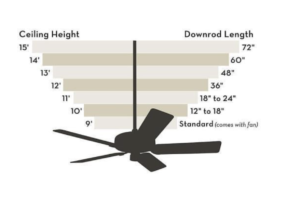
A ceiling fan is composed of fan blades, a downrod, and an installation base.
The installation base attaches to the ceiling. The downrod connects to the base. And the fan itself hangs from the downrod.
Per the measurements mentioned above, the fan must be at least 7 feet and 6 inches above the ground if you have a standard 9 foot ceiling.
There is one exception: fans placed above beds, where you will not walk, require less height.
Many downrods match the color of the fan. So if you want a back ceiling fan you will likely want a complimentary black downrod to go with it.
Many people enjoy selecting the fit and finish of the downrod as these pieces of metal or plastic come in different colors, shapes, and sizes and compliment the overall fan’s aesthetic.
As a general rule, more expensive ceiling fans enable you to have longer and more customizable downrods. The downdrods tend to be longer – between 6 and 18 inches.
This is for functionality and aesthetics. Cheaper ceiling fans sometimes have very short – or almost nonexistent downrods – because the base and the fan are fused together.
Design and Look: What to Think About the fan’s general aesthetics
A hugely important aspect of a ceiling fan is what it looks like. If you see the fan while lying in bed or while in your living room you will want it to look great.
The base and downrod are not nearly as important as the blades for how a fan looks in a room.
Blades come in different cuts, lengths, seizes, finishes, colors and of course quantities.
When people think of a black fan, they often think of black blades and a matching flush mounting and downrod.
This is important to clarify: when buying a black fan do you want the entire unit to be black or only a portion? Do you want all black exteriors (blades, motor casing, and downrod) or only black blades?
These are minor but important details to think through. Many people love the idea of having a consistent color scheme.
How many blades should a black fan have?
At a minimum, a ceiling fan will have two blades though four or five are certainly more common.
A two blade fan can be made of one long piece of metal connected at the mid-point or two distinct blades.
One type of ceiling fan, called a windmill fan, can have upwards of 20 blades packed tightly together.
Blades add functionality and impact the air flow.
When you look at a fan that is turned on, the blades are hard to see. When the fan is stationary, however, the design and color of the blades will need to align with your preferences for style and decor.
Fans with four to six blades produce a lower pitch, softer volume noise output. Three blade fans use the air surrounding the fan most efficiently and require the least effort to clean as you have fewer blades and surface area to collect dust.
Windmill fans, always popular in kid’s rooms, have the most surface area of blades. This increases the effort to clean and dust these fans.
The shade of black, material, and quantity of the blades impact how the fan looks and performs.
Another subtle variable is at play too: the angles of those blades. If the blades are too flat, they won’t whisk through the air and create air flows. We highly advise blades with angles between 12 and 14 degrees.
Nearly all of the fans we provide you here have angles in that range for optimal air circulation and air flow efficacy.
More than a fan: how a black fan provides lighting, symmetry, and aesthetic benefits.
Some people buy ceiling fans simply to cool or heat a room. Others buy ceiling fans because they can be elegant and add character to a home. Some fans have lights and others do not.
If you are going to place your fan in the center of a room – for example, your living room – you might do so at the expense of a central lighting system.
For this reason, adding lights to fans is popular. If you add lights you will want to also consider how easy it is to change the bulbs, especially if the fan is very high above your floor.
LED, Halogen, and Fluorescent lighting options are available on all fans that have integrated lighting. Here is a 6 blade, black ceiling fan with a black downrod, black flush mounting, and a downward facing light.
Control Your Environment: Noise and Air Flow
Fans without lights produce two types of energy outputs when they are on: noise and air-flow. Both will impact your experience with the fan. Fans with lights also produce illumination as an energy output.
Firstly, noise is a byproduct of any fan. The rotation of the blades and the motor can cause distinct sounds. Larger motors produce more power and, as a result, can generate more noise.
The good news is that noise can be mitigated.
Motors that are built from higher quality and durable screws, armature, bearings, windings, and rotors are more expensive.
Cheaper fans have motors that usually produce more noise as a byproduct.
If you want a quieter fan, buy a more expensive one. You won’t regret it.
Please pay particular attention to this when considering which type of fan you will place in different rooms in your home. If you are considering a bedroom ceiling fan, it is prudent to optimize for minimal sound.
People tend to care less about noise when a fan is in a garage or bathroom.
The second type of energy output is air-flow.
Fans can not only cool rooms, they can also heat rooms and reduce air moisture.
They substitute central cooling or work in conjunction with air conditioning.
Fans do not lower air temperatures. They produce air flows and circulation which can in turn create the effect of a windchill.
The wind chill temperature is how cold people feel. The air flow, which leads to evaporative cooling (deratification), is generated by the ceiling fan.
If you are using a fan for general room cooling, you will want a fan that accelerates the heat loss from exposed skin.
Put simply, you will want a fan that generates significant air-flows point downwards and towards the center of the room.
Air Flow Deep Dive: Cubic Feet per Minute
Air flow is the volume of air that is produced by the fan.
The most common way to measure air flow is Cubic Feet per Minute (or CFM).
All of the fans we review have a CFM rating so that you can easily compare how much air that each fan produces.
The average CFM is around 5,000.
For nearly all non-industrial use-cases, like your home bedroom, kitchen, living room, or garage, a CFM of 6,000-7,000 is optimal.
At this rate you will be left feeling cooler without greatly enhancing your energy bill or having papers strewn all over the place from the powerful wind currents that larger fans produce.
You might also see a measurement similar to CFM which is air (or wind) Miles Per Hour.
Much like measuring the speed at which one drives, a fan can have its air speed measured too.
Nearly all fans produce between 3 and 5 Mile Per Hour air flows. Naturally, the higher the MPH, the stronger the air flows.
Controlling Your Fan and Your Energy Output for Efficiency
Mobile apps and the internet have changed how we communicate, manage, and control various technologies.
Ceiling fans are no exception.
Ceiling fans are well suited for management by a digital switch, remote, or mobile app because you can power the fans on or off (or even alter the speed) from afar.
A connected fan is controlled via a remote control or smartphone. In contrast, less expensive and simpler fans are controlled via a manual switch.
Lastly, some ceiling fans are controlled by pull chains.
While chains are usually made long enough for all users to reach them, please keep in mind that this can cause discomfort or annoyance on high ceilings or fans that need to be frequently turned on or off. Nearly all black fans have matching black pull chains.
If you plan on installing your fan over 9 feet above the ground, you should buy a fan that can be controlled digitally.
All ceiling fans can create air-flows bi-direactionally.
Usually a simple switch exists on the fan’s motor or external base that enables you to change the direction in which the blades rotate.
Changing the directional air propulsion is critical during the winter months.
Rather than have air convected from the center of the room for cooling, you will want air to move from the blades horizontally down through the walls.
Lateral air-flow is used for heating rooms and maintaining central warmth while reducing your energy bill.
Choosing the right ceiling fan direction
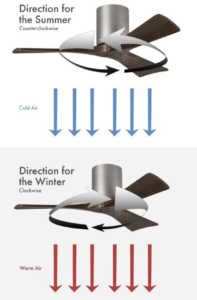
How you control your fan is correlated with how much energy your fan uses. Will you leave it running all the time? Or will you use smart logic to power it down after a certain amount of time?
We have gone above and beyond to think about fans not just as cooling mechanisms but as a tool that can help you save money while lowering your ecological footprint. These efforts will, most importantly, save you money.
Let me explain further.
When you use central cooling or air conditioners, you are physically reducing the temperature in a room.
An air conditioner sucks air into its ducts through a vent. This air cools the gas in the evaporator and as the heat is removed from the air, it is cooled. Cool air then flows into your room.
This process is energy intensive and expensive.
In contrast, a ceiling fan does not cool the room or remove heat. Rather, it moves air around which creates the feeling of cooling. Actual cooling is not occurring. Less energy out means less energy in. And in total this means a lower energy bill.
What A Fan Looks Like To You and Others
This guide provides ample information pertaining to how a ceiling fan works and things you should be aware of before buying one or many fans for your home.
What we have not discussed in great depth is how a fan looks and the importance of design aesthetics.
A fan will need to fit aesthetically into your room and, as a result, you should think about material (wood, metal, plastic), color, and design patterns. Some questions to reflect on:
- Is the room light or dark? Is it naturally well lit or does it require lots of electrical light?
If your ceiling fan is going in the center of your living room, for example, you will likely want a fan with built-in lighting. This is because many living rooms have existing fixture hardware and wiring.
- Do you want a smart fan that connects with your digital applications and services (Google Home, Nest Apple Siri, Amazon Alexa)?
If you control other aspects of your home – like the temperature and humidity – via smart apps, you might want to add a ceiling fan as another connected Internet of Things device. Likewise if you have high ceilings and plan to install a fan that you can’t easily reach by hand.
Smart fans can be controlled via your phone, tablet, or voice, and these controls will make turning them on or off easier.
- Do you want a windmill fan?
Windmill fans are harder to clean (more blades means more surface area for dust to land and accumulate). On the other hand, windmill fans are quiet and elegant.
This type of fan is also hugely popular in kids rooms and living rooms.
The windmill fans pay homage to an older design aesthetic.
While this fan is not modern chic it goes very well in rooms with wooden floors or darker walls because it is made of simple plastic or wood finishes, glass fiber reinforced polyester, and thin pulp-plastic infused blades.
- What shade of black do you want the fan? What style finish do you want?
Sleek and minimalist fans have fewer blades. These fans, made of lightweight metal, have universal black finishes. Here are popular black finishes that you can check out to see which finish you think looks best:
- Dim
- Ebony
- Dark Gray Black
- Charcoal
- Outer Space
- Jet Black
Black adds sophistication and class to any room. Black fans look great and match lighter room color schemes with ample natural light.
Where to buy a black ceiling fan?
Ceiling fans are heavy and can be difficult to fit in a car or to transport yourself unless you have a large vehicle or flat-bed truck. Given this, it makes a lot of sense to have your fan shipped to you so that it arrives ready for home assembly.
You can self-install a ceiling fan. This work requires moderate technical skills and physical strength. This is because you will need to install not only the fan (the blades) but you will need to connect the fan’s base to the ceiling and its electrical fixture hardware and wiring.
How much do ceiling fans cost? What impacts the price of a fan?
Black ceiling fans range in price from $100 on the cheap-end to over $1,500 on the high-end. There are several reasons why the range in price is so large.
A ceiling fan, made of plastic instead of more durable wood or metal, is cheaper.
Additionally, less expensive black fans have weaker motors. This means that they are capable of producing less air flow or have smaller Cubic Feet per Minute scores.
More expensive fans are akin to those you would experience at a resort or high end hotel. A ceiling fan over $1,200 will likely come packed with high tech solutions built-in.
These fans will enable you to:
- Program the fan based on motion, temperature, or humidity.
- Turn the fan on or off based on preset logic or rules for maximum physical comfort.
- Enjoy very efficient and quiet DC motors that have multi-decade support and lifetime expectations.
Moreover, these pricer fans come with app based (smart phone, iPad) mobile management and remote controls.
It is common for expensive ceiling fans to come with mount options so that you can install a panel adjacent to your light switch. These wall mounts enable you to control not only the fan (on/off) but also the fan speed and direction.
Cheaper fans do not come with these in depth level of controls or sophisticated management features.
And that is ok. Simplicity might be what you crave.
Cheaper fans cool rooms as well and can be easily turned on/off with pull chains.
Less expensive fans (in the $100-$300 price point) still come with energy-efficient dimmable lightbulbs.
AC vs DC fans: Understanding a fan’s power source
Most inexpensive black fans leverage AC motors.
Although AC motors are more powerful than DC motors, they typically are less efficient and are not as good at using their energy output.
This can cause additional noise (thereby making it harder to sleep if that fan is in your bedroom).
When buying a fan, please take a moment to see the Power Source listed in the fan’s essential product information that all suppliers provide. If you buy a fan with an AC motor, it will be louder.
As a result, we highly advise buying a DC powered fan if you will be sleeping near it.
AC motors are durable and longer lasting. While this might seem positive, DC motors are better (and therefore more costly).
DC motors are simpler to install into the fan’s base, have high startup power, and have a faster response time.
This means that time will be shortened from when you switch the “on” button to when the fan is accelerating to cool your room.
Although more expensive, ceiling fans with DC motors consume 70% less power which will enable you to save money over time as you pay less to power them.
Where to place the ceiling fan: voltage and flush mounting
Many people place their ceiling fans in the center of a room or above a bed. This is to maximize comfort and the impact of the fan’s air flows.
A centrally placed black ceiling fan also creates room symmetry.
Voltage is the pressure from an electrical circuit’s power, and the most common electrical outlet in any home is a 110 volt. If you live in the United States, you will need to select a fan that complies with this voltage limit.
Luckily for you, nearly all off-the-shelf ceiling fans support this standard.
When installing a ceiling fan you will need to get a few things absolutely right. We have done this many times for ourselves, our family, friends, and of course our clients.
Firstly, some ceiling fans support flush mount integrations. Flush mount fans sit directly against the ceiling and point downwards. These fans are typically useful for cooling a small room.
Not all ceiling fans are flush mountable.
This means that they will hang lower from the ceiling. If you buy a fan that cannot be flush mounted, please ensure that the lower point of the fan is at least 7 feet and six inches from the ground.
Additionally, ensure that the weight bearing load of the ceiling can support the fan.
Similar to voltage, this should be routine in many homes.
But it is worth investigating because you don’t want to buy a fan just to see it unable to stay upright.
For most fans that we review and see our clients deploy, a ceiling must be able to support approximately 35 pounds of downward pressure.
Buyer’s Guide Summary: Bringing It All Together
Buying a black ceiling fan for the first time does not need to be overwhelming.
Simply follow this guide to evaluate and buy the fan that fits best in your room and adds the most value in your life.
Don’t get bogged down in the details. If nothing else, pick a fan that looks great, fits well within your room, and that is priced according to your budget. Try to select a shade of black that you think will match the room the ceiling fan will be placed in.






